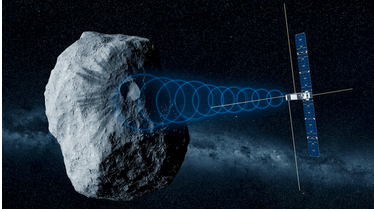JuRa radar arrival brings ESA’s Hera closer to launch
10th Aug 2023
A tiny radar that will study the asteroid that NASA’s DART spacecraft crashed into in 2022 is one step closer to launching into space after arriving at the European Space Agency (ESA). ESA is set to complete the first post-impact survey of Dimorphos through the Hera mission, which is focused on understanding more about the object’s characteristics, and how DART impacted the orbiting moonlet of 65803 Didymos.
JuRa is a miniature radar that will fly onboard Juventas, one of Hera’s CubeSats, and will help peer up to 100 meters into the surface of the asteroid and study its internal structures through radar imaging. According to a press release from ESA on 10th August, the radar has been delivered for integration aboard the Juventas CubeSat.
ESA’s Hera Mission
In November 2021 NASA launched a spacecraft, called NASA’s Double Asteroid Redirection Test (DART), to crash directly into the 160-meter-diameter Dimorphos asteroid. In September 2022, DART rendezvoused with the object, and the spacecraft successfully demonstrated its effectiveness by reducing Dimorphos’ orbital period around Didymos by 32 minutes through its impact.
The mission was the first step in testing whether kinetic impact with an asteroid can be used as a means of planetary defence against near-Earth objects (NEO) that could pose a potential threat. Following DART, ESA was tasked with the second part of the mission.
Hera will carry two CubeSats, called Juventas and Milani, that will focus on surveying various elements of the asteroid. Following Hera’s completion of the subsurface radar imaging campaign of the asteroid, the 6-unit Juventas CubeSat will be released to rendezvous with Dimorphos and begin to determine the gravity field of the object, its surface properties, and interior structures – which is where JuRa comes in.
All about JuRa
JuRa is tiny. In fact, it measures 9.5×9.5×9.5 centimeters across and can fit in just one of Juventas’ units. JuRa’s 60MHz radar electronics were developed by Luxembourg-based EmTroniX, and the instrument’s principal investigator is the Institut de Planétologie et d’Astrophysique de Grenoble (IPAG) in France. The radar is set to operate for 45 hours during the two-month lifetime of Juventas.
“It feels good to deliver something to our customer, but it will feel even better once everything is fully integrated and tested,” said Cedric Lorant, EmTroniX co-founder and CEO. “Once JuRa is integrated with the rest of the Juventas CubeSat, and we perform remaining tweaks such as re-flashing it to the latest firmware, then we will assess how the instrument performs within its working environment.”
The radar design was developed in partnership with the Chair for Radio Frequency and Photonics Engineering of Technical University Dresden and is derived from the same instrument flown on ESA’s Rosetta mission.
“JuRa is a small, low-frequency, radar for a small body, compared to the bigger instruments we have put together for planetary targets,” said Alain Hérique from IPAG. “As with Rosetta around 67P, we take advantage of the fact we will be orbiting relatively slowly around the Dimorphos asteroid”.
ESA says Hera will be moving at a few meters per second around the asteroid.
JuRa will deploy a quartet of 1.5-meter-long antennas that are placed perpendicular to each other to provide a circular polarisation radar signal, according to ESA, which places “fewer constraints on spacecraft operations and providing easier-to-interpret data on both Didymos asteroids.” The antennas were manufactured by the Polish space company Astronika.
The results of the radar imaging will completely depend on Dimorphos. Hérique added: “Juventas will perform the very first radar probe inside an asteroid. I expect to see deep inside, but the radar penetration depends very much on what’s inside; if it’s a pile of sand we’re going to have low scattering and penetrate deeper, compared to larger boulders with higher scattering and not seeing so far. This is one of the main unknowns we want to measure”.
Hera is scheduled to launch in October 2024, followed by a rendezvous with Dimorphos in December 2026. Ahead of the launch, the JuRa teams will continue working on operating procedures to determine how the radar will work in practice, and how they will communicate with the instrument.







Thank you for your comment! It will be visible on the site after moderation.